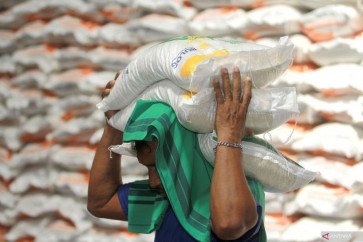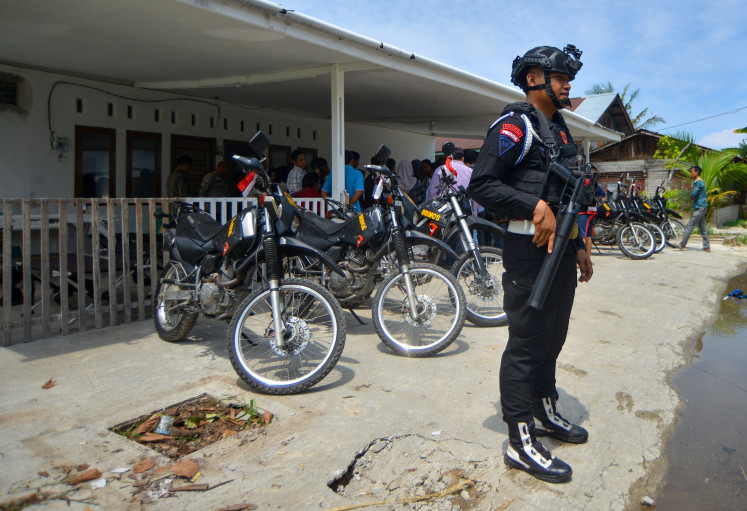Popular Reads
Top Results
Can't find what you're looking for?
View all search resultsPopular Reads
Top Results
Can't find what you're looking for?
View all search resultsIn search of Cingkuak Island
Prize: The tiny island of Cingkuak was the springboard for the Dutch colonization of nearby Padang â and the site of an apparently lost Portuguese colony
Change text size
Gift Premium Articles
to Anyone
P
span class="caption">Prize: The tiny island of Cingkuak was the springboard for the Dutch colonization of nearby Padang ' and the site of an apparently lost Portuguese colony.
A couple was recently overheard arguing about the origin of the name of Cingkuak Island.
'It's the name of the foreign panglima [commander] who first visited this island, a Chinese admiral,' said the man.
'No,' said his wife. 'The name comes from a species of monkey that used to roam here.'
The husband and wife were serving customers in a thatched food stall as white sands stretched toward the bay on Carocok Beach. The stall offers a gorgeous view, with the Bukit Barisan mountains that traverse West Sumatra in the background.
Idyllic: The clear, shallow and white-sand bay where tourists can enjoy themselves on Cingkuak Island.
One local academic believes that the name Cingkuak is derived from Admiral Cheng Ho, who sailed to Sumatra six times in the 15th century.
Legend has it that Cheng Ho, who was Muslim, once landed here, although records show that the legendary seafarer only passed through the Malacca Strait and never visited this part of Sumatra.
The island has been given many names by visitors, including Poulo Chinco or Poulo Chinko (according to the Kaartcollectie Buitenland Leupe) or even Poeloe Tjinko, Poelau Tjinkoek or Pulu Tjinkuk.
Cingkuak: The island may have been named for an ancient Chinese admiral or even a local monkey.
Local residents, however, always call it Cingkuak.
The name might be a reference to the cingkuak, a local monkey species with dark gray fur and a black spotted face. Cingkuak literally means 'stained' in the Minang language spoken here.
Although rarely seen today, the primate survives in the forest of West Sumatra.
The Portuguese, though, were the ones believed to have introduced the name Poulo Chinco, which was later adopted by another set of colonizers, the Dutch, when the VOC set up shop on the island in 1662.
However, the origins of the Portuguese influence on Cingkuak and on West Sumatra remain a mystery. They have influenced local culture and are mentioned in local oral histories, although there is scant written documentation of their tenure here.
For example, the 4.5-hectare island has a heritage building that local residents call the Portuguese Fort, which was repaired by the Batusangkar Regency Archeological Conservation Center 1996.
Look upon my works: The remains of the western gate of the Portuguese Fort on Cingkuak Island.
Only a few stones and bricks from the east and west walls of the fort and its gates currently remain.
'The name 'Portuguese Fort' has been retained, as islanders have never called it the VOC or the Dutch fort,' Yusfa Hendra Bahar, from the center's team studying the preservation of the fort area, told The Jakarta Post.
According to records, the fort was taken over by the VOC, short for the Dutch East Indies Company, in 1662, and used for about century as a springboard for the Dutch colonial occupation of Padang.
Mysteriously, Salido, a nearby coastal city with gold mines that attracted colonial interest, also had a Portuguese-tinged name. A Dutch official in Padang in 1821 even eported that local residents told him that there were once ruins of buildings owned by the Portuguese located south of Padang.
Rusli Amran's History of Padang, however, said that there was no evidence in the Dutch, French and Portuguese libraries he surveyed alluding to a Portuguese presence on the west coast of Sumatra.
'The possible conclusion,' Rusli wrote, 'is that the Portuguese, once arriving in Padang or its vicinity, never returned home.'
Perhaps they were shipwrecked, perhaps they married into local families, he adds. The Portuguese might have even been killed, although Rusli said that was unlikely.
However, the author said that it was 'almost certain' that the Portuguese were the first Europeans to settle in West Sumatra. 'Otherwise, there could have been no such influences.'
The ships of the VOC's fleet first appeared off Sumatra during the reign of Sultan Indrapura.
The Dutch set up shop near the gold mines of Salido in 1646, shifting to a more secure base on Cingkuak Island in 1662.
Cingkuak became the VOC's foothold on the western coast of Sumatra, similar to Fort Marlborough of the English in Bengkulu, southwest of Sumatra.
Apart from serving as a trading port, the island was several times subjected to joint control through agreements between the Dutch and the Minangkabau kings of West Sumatra.
Mining rights for Salido were given to the VOC by Sultan Indrapura and King Tarusan in July 1667, who both eventually gave dominion of Cingkuak Island to the Dutch. After three years, the VOC began mining and built Fort Cronenburg there.
However, it was not as prosperous as expected. Despite the intervention of experts from Europe, gold output was never good and the operation was shut down after 26 years, reopening briefly in the early 18th century.
Besides the ruined fort walls, this island has the remains of a wharf and a stone building on its east coast and a tombstone for one Madame van Kempen.
'Memento mori': The tombstone of a Dutch colonist named Madame van Kempen, who died on Cingkuak Island in 1767.
The Dutch fort was assaulted by British troops during the Napoleonic Wars, when the two nations were enemies.
Under false flags ' an acceptable ruse de guerre at the time ' a squadron of British warships from Bengkulu approached the fort on Aug. 16, 1781.
The two dozen soldiers of the garrison could not resist and cannon of reduced the fort to rubble.
After conquering Cingkuak, the British seized the Dutch fort in Padang on the next day and controlled it for three years.
The small island has also suffered from tsunami, with Dutch writers recording that the island was swept by monster waves on Feb. 10, 1797 and Nov. 24, 1833.
Today, however, the island is a popular tourist destination in Pesisir Selatan regency, about 60 kilometers from Padang.
Get away: Cingkuak Island (center) viewed from Carocok Beach in Painan.
No warships are needed to get to the island either. From Carocok Beach, visitors can reach the Cingkuak by a 5-minute motorboat ride for about Rp 20,000 (US$1.74).
' Photos By JP/Syofiardi Bachyul Jb















